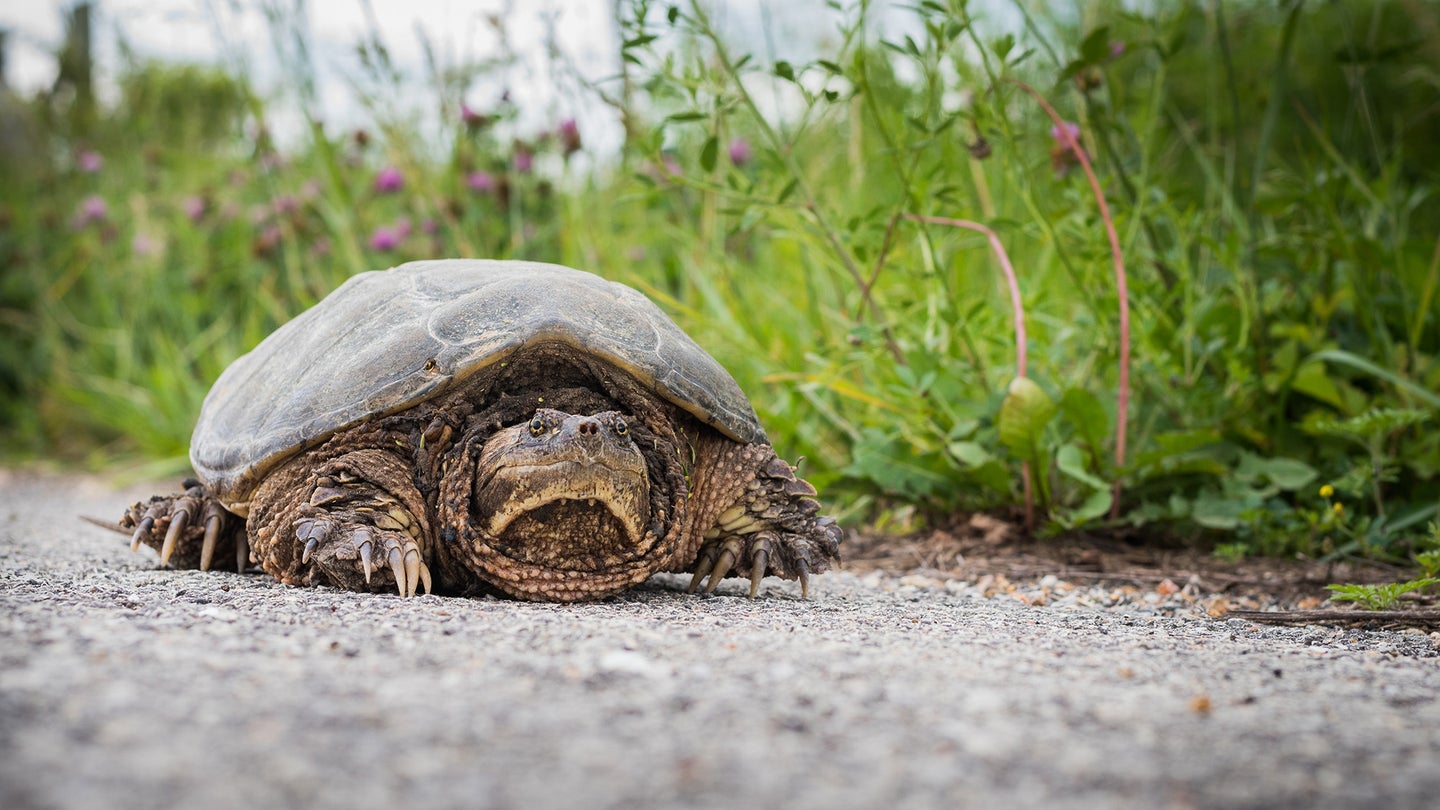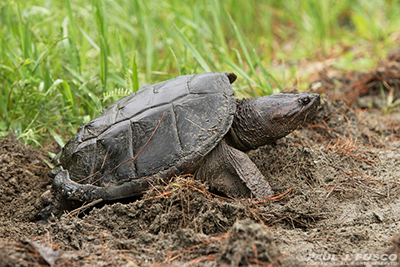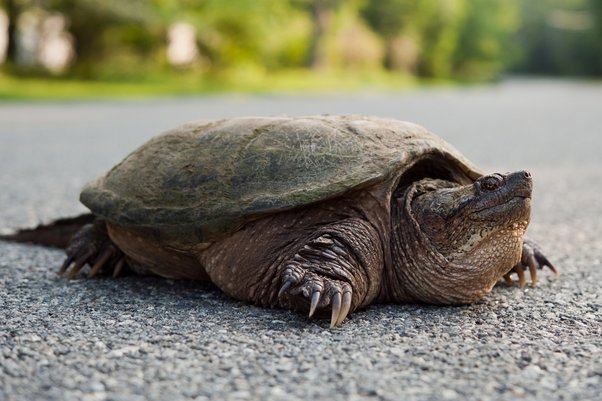Snapping turtles eat by using their sharp beaks to catch and tear apart prey. They are omnivorous scavengers.
Snapping turtles are fascinating creatures known for their unique feeding habits. These turtles use their strong jaws and sharp beaks to catch and tear apart various types of prey, including fish, insects, amphibians, and even small mammals. Their diet also consists of plants, algae, and carrion, making them opportunistic feeders.
With a keen sense of smell and an ambush hunting style, snapping turtles are adept at capturing their prey in the water. Their powerful jaws allow them to consume their food whole or in large chunks. Understanding how snapping turtles eat sheds light on their important role in maintaining the balance of aquatic ecosystems.

Credit: www.fieldandstream.com
Hunting Strategy
When it comes to hunting strategy, snapping turtles employ a combination of techniques to catch their prey. Their hunting methods are influenced by their environment and the availability of food sources. Understanding the hunting strategy of snapping turtles sheds light on their behavior and survival instincts.
Ambush Predators
Snapping turtles are skilled ambush predators, patiently waiting for their prey to come within striking distance. They often hide in shallow water, partially buried in mud or sand, with only their eyes and nostrils exposed. This stealthy approach allows them to surprise unsuspecting prey, such as fish, frogs, and small mammals, as they venture near the water’s edge.
Opportunistic Feeders
Snapping turtles are opportunistic feeders, taking advantage of various food sources within their habitat. They are known to scavenge on carrion and consume a wide range of aquatic plants, insects, and even small reptiles. This adaptable feeding behavior enables snapping turtles to thrive in diverse ecosystems, from lakes and rivers to marshes and swamps.

Credit: portal.ct.gov
Diet Composition
Snapping turtles are opportunistic feeders, consuming a wide variety of prey and carrion. Their diet composition plays a crucial role in their survival and ecological impact. Understanding what snapping turtles eat is essential for appreciating their place in the natural world.
Variety Of Prey
Snapping turtles have a diverse diet, feeding on aquatic plants, insects, fish, amphibians, reptiles, birds, and small mammals. They are known for their ability to consume almost anything they can overpower, making them effective scavengers and predators in their environment.
Carrion Consumption
Snapping turtles are also known to consume carrion, playing a vital role in the ecosystem by recycling nutrients and cleaning up decaying organic matter. They are often observed feeding on dead fish, waterfowl, and other animals, contributing to the natural decomposition process.
Jaw Mechanism
The snapping turtle’s jaw mechanism is designed for powerful biting and tearing, enabling them to consume a wide range of prey, including fish, amphibians, and even small mammals. Their unique feeding strategy involves using a quick and forceful motion to capture and devour their prey, showcasing the remarkable adaptability of these fascinating reptiles.
Snapping turtles are known for their powerful jaws and aggressive nature. Their jaw mechanism is unique and allows them to easily capture and consume their prey. Let’s take a closer look at how snapping turtles eat, focusing on their jaw mechanism, powerful bite force, and adaptations for feeding.Powerful Bite Force
Snapping turtles have one of the strongest bite forces of any animal. Their sharp beak-like jaws can easily crush through tough shells and bones. This allows them to eat a variety of prey, including fish, frogs, snakes, and even small mammals. Their powerful bite force is due to their strong jaw muscles and unique jaw structure.Adaptations For Feeding
Snapping turtles have several adaptations that make them successful hunters. Their necks are long and flexible, allowing them to quickly strike at prey. They also have a keen sense of smell, which helps them locate food in murky water. Their tongues are covered in small barbs that help them grasp and hold onto prey. Additionally, their powerful jaws can create a suction-like effect, pulling in water and prey. Overall, the jaw mechanism of snapping turtles is a marvel of nature. Their powerful bite force and adaptations for feeding make them successful hunters in both water and on land.Feeding Behavior
Feeding behavior is an essential aspect of understanding snapping turtles. These fascinating reptiles have a unique approach to feeding, which involves a combination of patience and tactile sensitivity.
Slow And Patient Approach
Snapping turtles exhibit a slow and patient approach to feeding. When hunting for prey, they rely on their keen sense of sight and smell to locate potential food sources. Once a suitable meal is identified, the turtle will slowly and stealthily approach its target, taking its time to ensure a successful capture.
Role Of Tactile Sensitivity
The role of tactile sensitivity is crucial to the feeding behavior of snapping turtles. These reptiles possess highly sensitive receptors in their jaws, allowing them to detect even the slightest movement or vibration in the water. This tactile acuity enables snapping turtles to accurately pinpoint the location of prey, facilitating effective hunting and feeding.
Challenges Faced
Snapping turtles are fascinating creatures with unique eating habits. However, they face several challenges when it comes to their feeding behaviors. Understanding the challenges they encounter can shed light on the importance of conservation efforts and the impact of human activities on their habitat.
Human Impact On Habitat
The increasing human presence near water bodies has led to habitat destruction for snapping turtles. This has disrupted their feeding patterns and made it difficult for them to find suitable prey. Pollution and littering also pose a threat, as turtles may ingest harmful substances while feeding.
Conservation Efforts
Conservation efforts play a crucial role in ensuring the survival of snapping turtles. By protecting their natural habitats and implementing measures to reduce human impact, conservationists can help these creatures thrive. Educational programs and awareness campaigns can also highlight the importance of preserving the ecosystems where snapping turtles feed.

Credit: www.fieldandstream.com
Comparison With Other Turtles
Snapping turtles are one of the most fascinating creatures in the animal kingdom. With their sharp beaks and powerful jaws, they are known for their aggressive nature and ability to snap at anything that comes in their way. When compared to other turtles, snapping turtles have unique feeding techniques that set them apart. Let’s explore the contrast in feeding techniques and evolutionary advantages that make snapping turtles stand out.
Contrast In Feeding Techniques
When it comes to feeding, snapping turtles have a very different approach than other turtles. While most turtles are herbivores and feed on vegetation, snapping turtles are omnivores and feed on both plants and animals. They have a diet that includes fish, frogs, snakes, birds, and even small mammals. Snapping turtles use their powerful jaws and sharp beaks to catch and crush their prey. They have a unique feeding technique where they will strike quickly and with great force to capture their prey, and then swallow it whole. This makes them efficient predators and gives them an advantage over other turtles.
Evolutionary Advantages
Snapping turtles have evolved to have a unique set of adaptations that make them effective hunters. Their powerful jaws and sharp beaks are perfectly designed to catch and crush their prey, and their strong neck muscles enable them to retract their head quickly, protecting them from predators. Additionally, snapping turtles have a unique respiratory system that allows them to stay underwater for extended periods, giving them an advantage when hunting aquatic prey.
| Comparison | Other Turtles | Snapping Turtles |
|---|---|---|
| Diet | Herbivores, feeding on vegetation | Omnivores, feeding on plants and animals |
| Feeding Technique | Slow and steady, grazing on vegetation | Quick and forceful, striking at prey |
| Adaptations | Not as specialized for hunting | Powerful jaws, sharp beaks, strong neck muscles, unique respiratory system |
Overall, snapping turtles have unique feeding techniques and evolutionary advantages that set them apart from other turtles. Their ability to feed on both plants and animals, combined with their powerful jaws and unique adaptations, make them efficient predators and give them an advantage in the animal kingdom.
Conclusion
In wrapping up, snapping turtles have unique feeding behaviors. Their strong jaws crush prey efficiently. Understanding how they eat aids in conservation efforts. Protecting their habitats ensures their survival. These fascinating creatures play a vital role in the ecosystem. So, let’s appreciate and conserve snapping turtles.






Leave a Reply